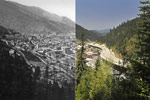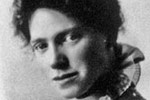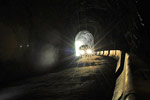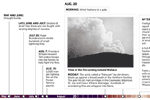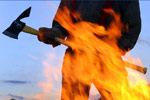Flame and Ruin: The fires of 1910
The 1910 fire: A region consumed
Today, we can imagine the smoke – thick and suffocating. We can fathom the flames – causing mountains and towns to glow red at midnight. We can even imagine the heat, enough to peel paint off boxcars. Yet there's one thing the survivors said was impossible for anyone to imagine: The roar.
A forest the size of Connecticut was exploding in a fearsome whoosh – generating, with fire and oxygen, its own tornadoes and cyclones. One survivor called it “the sound of a thousand trains rushing over a thousand steel trestles.” Another said it could be compared only to the “roar of Niagara Falls.”
The noise was a deafening combination of 60 mph gales, colossal fire-driven updrafts, and the clamor of hundreds of trees cracking, snapping and slamming against earth. One witness said it sounded like being in the midst of “heavy cannonading.”
Some came to call it The Big Blowup. Others called it the Big Burn. By any name, it was easily the biggest forest fire in the Inland Northwest’s history – actually the biggest forest fire in U.S. history.
Read the rest of the storyAlso see
View The fires of 1910 in a larger map
Monday, August 16
Bike trail cuts through heart of burn area
Last summer, 33,000 mountain bikers from all over the world rode the Route of the Hiawatha. This summer’s crowds are on track to break that record. The parking area at the East Portal will soon be doubled to handle the throngs. Do they have any idea they’re pedaling directly into the heart of the 1910 Big Burn?
Tuesday, August 17
Pulaski’s heroism resurfaced with discovery of tunnel
The west fork of Placer Creek is a friendly little stream, trickling through a narrow canyon lined with ferns and cedar trees. Follow a two-mile trail up the creek, and you come to the Pulaski Tunnel – a legendary part of the 1910 Fire story. It was here that Big Ed Pulaski ordered 45 firefighters into a mine shaft on the night of Aug. 20, and told them to lie face down.
“One man tried to make a rush outside, which would have meant certain death,” Pulaski later wrote. “I drew my revolver and said, ‘The next man who tries to leave the tunnel I will shoot.’”
Wednesday, August 18
Fire crews drew heavily from immigrants, laborers
With forests in flames from the Clearwater to Glacier National Park, the Forest Service had 10,000 men on the 1910 fire lines in Idaho, Washington and Montana. Their job: Keep the blazes from devouring valuable stands of timber, and protect nearby towns. Not surprisingly, much of the hot, dirty work fell to immigrants. The fire crews contained Croats, Latvians, Italians, Greeks, Germans, Scandinavians and Japanese. Some spoke no English. Others had no woodland experience. They joined other day laborers – a flotsam of itinerant men wandering the West.
Thursday, August 19
First-person narratives recall terror of 1910 fire
Aug. 20, 1910, was a night of terror for isolated settlers, prospectors and fire crews scattered in the mountains of North Idaho, Western Montana and Eastern Washington. Without radio communication or Weather Service bulletins, the nation’s largest fire storm caught many by surprise.
Eyewitnesses described the fearsome power of the swift-moving flames. “We saw a wall of bright red flame leap from the west ridge to the east ridge of Thomas Creek, a mile wide jump, in a moment of time,” recalled Orlando Scott of St. Maries. “Acres of timber went down in flash and no power on earth could save it ...”
Friday, August 20
Great fire wiped out wild towns of Taft, Grand Forks
Back in 1910, respectable folk believed that the wild, debauched towns of Taft and Grand Forks deserved to burn in hell. They got their wish. Both towns were wiped clean by the Big Burn of 1910.
Search for them today, and you’ll find nothing but a dusty and uninhabited freeway exit (Taft) and a tangle of undergrowth below the Route of the Hiawatha mountain-bike trail (Grand Forks). But from 1907 to 1910, those old towns howled.
Saturday, August 21
Great Burn Wilderness remains subject of debate
The 1910 fires – and significant wildfires that followed into the 1930s – had a devastating hand in bestowing rugged portions of the Bitterroot Mountains with new life. The landscape was so thoroughly blackened in some areas between Lookout and Lolo passes, loggers turned their attention elsewhere while nature found a new canvas for blending its palette of flora and fauna.
Fires had essentially banked a reservoir of wildness eventually recognized by national forest managers. And as the land has gradually been rediscovered by recreationists, a decades-old debate still smolders over proposals to designate roughly 275,000 acres along the Bitterroot Divide and Montana-Idaho border as the Great Burn Wilderness.
Sunday, August 22
Examining the legacy of the 1910 fires
One hundred years after the nation’s largest wildfires blazed across the Northern Rockies, blackening hillsides as far as the eye could see, the question lingers: Could the Big Burn happen again?
Absolutely, says Mark Finney, a research forester at the Rocky Mountain Research Laboratory in Missoula.
